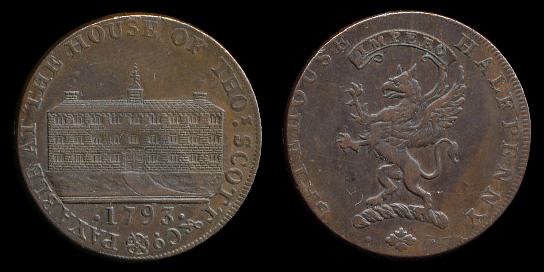The Gatehouse Halfpenny, 1793

Various attempts had been made to introduce copper coinage during the 100 years up to 1775. Partly because the price of copper had increased and partly because the monarchs thought it was too much of a base metal to bear their images, all attempts to produce farthings, halfpennies and pennies had ceased by 1775.
This was just at the time when the industrial revolution was gathering momentum. Up until this time workers were predominantly farm-based, with their payment being based on board and lodgings and their purchases were based on bartering.
The industrial revolution was ‘driven’ by the availability of power, and in Gatehouse motive power for cotton spinning was provided by water wheels. When power became available, more and more people came to work in towns and cities to work in the new 'factories', and this led to an even greater need for smaller denomination coinage to pay the workers and to allow them to purchase goods from the new ‘shops’.
As no national coinage was forthcoming, from about 1787 onwards, several wealthy landowners and businessmen arranged for the minting of local tokens to the value of a penny or a halfpenny. Hundreds of these local currencies sprang up throughout the UK, followed by a need to exchange one town’s coin for another. Differences in values of each coin led to these currencies being unstable and they were banned from 1797 when UK-wide farthings, halfpennies and pennies were minted from copper and these have been with us ever since, even though some are no longer legal tender.
Scott’s Mill in Gatehouse (at the top of Ann Street) was the only business in Kirkcudbrightshire to issue its own coinage, now known as the Gatehouse Halfpenny. All those in circulation were minted in 1793.
A man called James Conder was a linen draper in Ipswich, and he produced a halfpenny token in 1794 bearing the town's market cross on the obverse, his name and business on the reverse. He became a keen collector of all the different tokens, and in 1798 he produced a book which listed the different tokens. The book proved popular with collectors such that many collectors refer to these coins as "Conder" tokens.